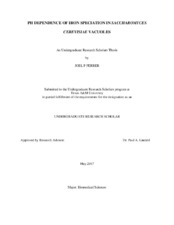| dc.description.abstract | Vacuoles in yeast are vital organelles that take on many important biological roles. They are responsible for collecting and detoxifying iron such that reactive oxygen species are not formed. They are also important storage organelles for many nutrients including iron. In fact, if enough iron is stored within the yeast vacuole, the cell is able to survive in iron deficient conditions. A model for iron trafficking in the vacuole has been proposed previously by Cockrell et al. which suggests that iron is imported as iron (II) where, once inside, it is oxidized to iron (III). Under standard conditions, it is known that yeast vacuoles tend to be more acidic, around pH 5, due to a proton pump encoded with many subunits one of them being VMA2. Because the molecule to which the iron is ligated with is based largely on the vacuolar pH, it is suspected that when the subunit corresponding to VMA2 is knocked out in vivo, the iron will favor nanoparticles rather than its polyphosphate ligand. Previously, it has been shown in vitro that this interconversion is possible however in vivo studies have not been conducted. In addition to the interconversion, it was hypothesized that, if the pH of the growth medium is lowered below pH 5, the acidic conditions will be able to “rescue” the cell from the perils of alkalinity. These hypothesizes were tested by growing Saccharomyces cerevisiae cells with a BY4741 background with and without the VMA2 subunit. The cells were then harvested and analyzed using a combination of biophysical techniques including Mössbauer spectroscopy, and electron paramagnetic resonance (EPR). As a result, it was seen that, indeed, this interconversion was possible in vivo. Moreover, when the subunit of the vacuolar ATP-ase was knocked out, there was a sizable increase in total cellular iron which suggests that extracellular pH of the growth medium affects the mitochondria resulting in a dysregulation in iron import. | en |


